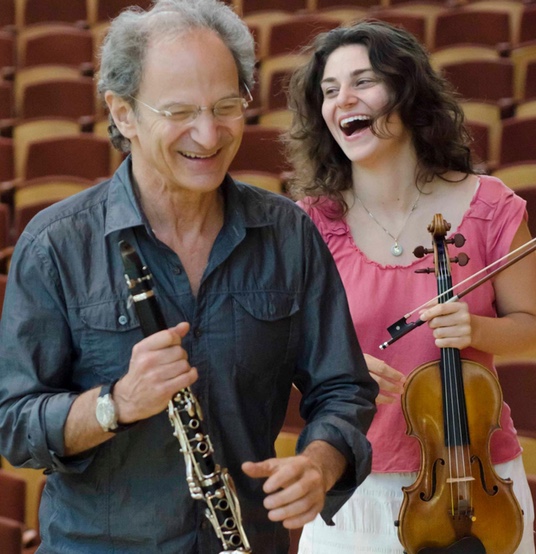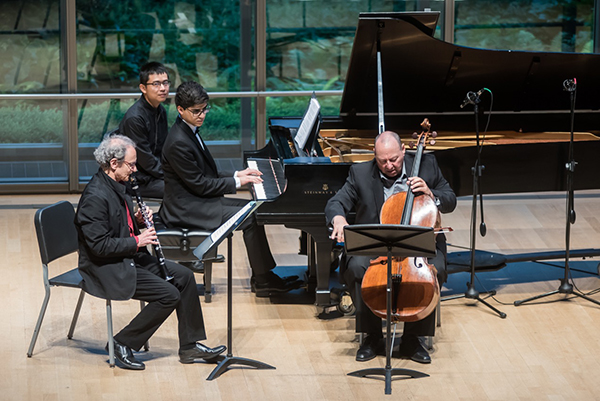by Rory O’Donoghue

Prior to the beginning of this year’s festival, I had the opportunity to talk with Cohen, principal clarinet emeritus of The Cleveland Orchestra and co-artistic director of ChamberFest, about the current season and the evolution of the Festival. Above all, he’s immensely appreciative of how far he’s come: “It’s just so wonderful to be able to do this, to have this life of music. I fell in love with music as a child, lying under the piano when my mother would practice. I couldn’t escape the spell, and still can’t.”
ChamberFest emerged in 2012 with its first season, Big Bang!, and has been on the rise ever since. The organization’s mission statement, “to nurture a deep family-like connection between musicians and audiences of all ages,” remains strong, in no small part due to the familial leadership between Cohen and his daughter, Executive and Co-Artistic Director Diana Cohen. The two of them have held a lifelong affinity for chamber music.
“Before I was in the Orchestra, I was very active as a chamber musician, and as a soloist,” Franklin Cohen said. “I met different people who were outside of the orchestral world, and so did Diana. We’ve always gone to chamber music concerts together — heard people, met people, got to know many folks who make their livelihoods playing chamber music.” Over the years, they’ve put this broad network of colleagues and contacts to use in cultivating the Festival’s guest artists. “Through the grapevine we can get in touch with just about anyone,” Cohen went on, “and then together we go to YouTube and listen to them. It’s really fun. We make decisions about who we want to play with — who’s a nice person, who we want to live with for a few weeks — and it all sort of works like that.”
Each year, they bring together a host of prominent artists from around the world for a few content-rich weeks of collaboration, all loosely organized under an overarching theme. 2019’s season is Under the Influence, which offers ten concerts over three weeks, performed by an impressive roster of 35 artists. Under the Influence “could mean anything, really,” Cohen began. “Basically — life. Composers are under the influence of what came before. Performers they write for, performances their works get, and the reactions. Anything you can imagine. We are all under the influence of each other, which changes every day. One could construe it very loosely. I couldn’t begin to tell you about how we crafted each program individually, and how we connect the dots, but we do try to tie everything together.”
This year’s concerts each have their own individual theme, all of which tie into the broader idea of influence. “Drugs, regions, composers, love, sadness, war,” Cohen rattled off the various categories at play, “crisis, earth, religion, madness, philosophy, virtuosity, illness, nostalgia, memory, transformation from the younger self, etc. — all these things, and on and on from there.”
Beyond direct spheres of influence, much of this year’s programming focuses on intergenerational exchange. On opening night on June 13, Cohen performed Beethoven’s Trio for Piano, Clarinet, and Cello in B-flat, Op. 11, with one of his oldest musical colleagues, cellist Peter Wiley. “I’ve adored playing with Pete for years, since our student days at Marlboro.” Their pianist was a much more recent acquaintance — Evren Ozel, second prize winner at the 2016 Thomas and Evon Cooper International Competition and current student at New England Conservatory. “He’s barely 19,” Cohen remarked, “and that kind of interaction between the old, the almost-old, and the almost-young is really a thrill. When we read it, it felt like we’d been playing together forever.”
After spending such a long time curating each of the programs, Cohen can’t pick a favorite concert. “When you’ve invested as much time and creative energy as my daughter and I have, it all has to be a highlight.” And he’s busy — he’s performing on seven of this summer’s events.“I didn’t realize I was creating a Festival with Diana that involves so much playing for me. We put the programs together, and she says, ‘Dad, are you sure you’re OK with all this?’”
Cohen’s performed most of this year’s pieces before, but he said they’re all still exciting for him. “The Beethoven is an old favorite – that slow movement is one of the most achingly beautiful things I’ve ever heard.” There are also works they keep on the horizon, hoping to program later on. “There’s certain pieces we love that we haven’t been able to do in the past. One of my favorites is the Dvořák Serenade, and we thought maybe this is the year to bring in a few extra people and do that.” It fits right in with the theme of Folklorica, which takes place on Sunday, June 23 at 2:00 pm in CWRU’s Harkness Chapel, and also includes works by Bruch and Bartók.
“We sometimes start with a theme for a concert, or one of these pieces specifically that we think is worth doing. Sometimes we go in reverse order — what might that be an anchor for?” During last Saturday’s concert, Cohen performed a hidden gem of the Romantic clarinet repertoire, Louise Farrenc’s Trio for Clarinet, Cello, and Piano in E-flat, Op. 44. “I thought it was really beautiful. Farrenc was a women’s rights activist way before it was really possible — she wanted equal pay because she thought her piano playing was every bit as good as the men, and she basically succeeded. I just love her Trio, and I was remarking yesterday that the whole thing puts a smile on your face. There might be one or two minor melodies, but she can’t stay there long. It’s really just a delight. I was worried because everyone who comes to the festival is a serious musician, and I thought they might think this was trite. But they all absolutely fell in love with it before they arrived.”
Cohen said that on concert number six — “Sei Solo” (You Are Alone) on Saturday, June 22 at 7:30 pm at CIM’s Mixon Hall — all of the pieces were written after the composers experienced a major lifetime loss. “We explore how profound that was, and what the music sounds like after that happened. It’s fascinating.”
Some of the themes come easily, like last Friday’s In Full Swing, because all of the music was very dancelike. Other programs, and the Festival’s broader umbrella theme, are harder to conceive. “It’s just the two of us, me and Diana, thinking things through,” Cohen explained. “We often joke about a competition during the festival — if you can come up with next year’s theme, we’ll buy you dinner at the nicest restaurant in town.”
Since its debut, ChamberFest’s upwards trajectory has been a glowing transformation. “In the beginning, nobody knew about it except a bit of the press, and close friends,” Cohen said. “Now, in our 8th year, in all my travels (which I’ve done quite a bit of since retiring from the Orchestra) I’ve discovered that people really know this festival. I can be very proud of that, for all of us who have worked to make it happen. In that way, it’s changed a lot. People really want to come here. They ask us if they can come back, and they’re excited to. At first, we had to really wrack our brains — who could we call and recruit.”
Because the reputation of the festival has changed, Cohen noted that their jobs have changed too. “When we look for people now, it’s not just for people we know. We get familiar with new names from different cultures and countries, hear them, talk to them, and get to know them. This year, I look at the list of artists and I’m very proud. The things we’ve wanted to do are all on the page. Now, all we have to do is play, of course.”
As for the future, Cohen hopes that ChamberFest will continue to expand. “With any young organization, especially in the arts, the challenge is getting together an infrastructure that works, and is sustainable over the years. Since we bring in internationally-known artists who are all busy during the rest of the year, we’re lucky we can do this in a concentrated three-week festival. I wish I could bring in my favorite musicians in the world to play whenever, and call it ChamberFest Whenever.”
One longtime goal of Cohen’s is expanding ChamberFest to the winter months, which would potentially lead to going on tour. Because each of their concerts involves different personnel, a tour would look quite different than that of an ensemble with regular members. However, with ChamberFest’s momentum and boundless enthusiasm, anything could happen.
“Above all, we want more young people involved,” Cohen said. “With our rising star program (formerly known as the young artist program), we’re bringing in many phenomenal young musicians.” Athena (16, piano) and Corina (11, violin) Deng opened In Full Swing, and represent the youngest batch of performers active in the Festival. “The juxtaposition of seeing my friend Pete Wiley, who has been in the Beaux Arts Trio and the Guarneri Quartet, on the same bill as kids like Athena and Corina — you realize that he was once that age, and how beautiful that is. How people evolve and grow, and what our lives have shown us through the path of music.”
Several of the past young artists have gone on to significant acclaim, like Alexi Kenney, who gave a solo violin recital titled Bach to the Future last Tuesday, featuring works from Bach to Berio to Thurídur Jónsdóttir. “He came here in maybe his second year at NEC. He’s been with us for four years, and of course now he’s graduated, and he’s as hot in demand as it gets,” Cohen said. “It’s just beautiful that he got his feet wet at ChamberFest.”
Under the Influence spans four generations of performers, but Cohen isn’t stopping there. “Of course I’m the oldest,” he joked, “and we don’t have any 90-year-olds yet. Maybe someday we will, when I get up there, and we can say we’ve got five generations. That would be wonderful.”
There are six more concerts in ChamberFest 2019 this summer, with tickets and additional info available here.
Photos by Gary Adams.
Published on ClevelandClassical.com June 20, 2019.
Click here for a printable copy of this article




